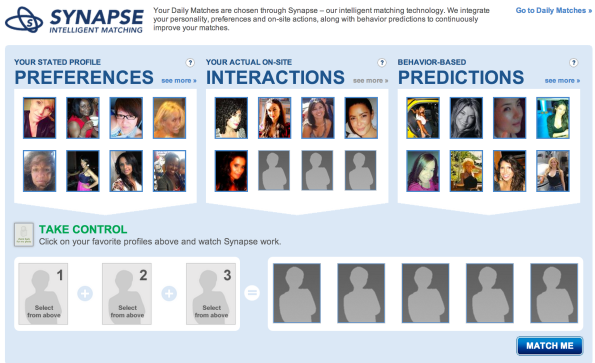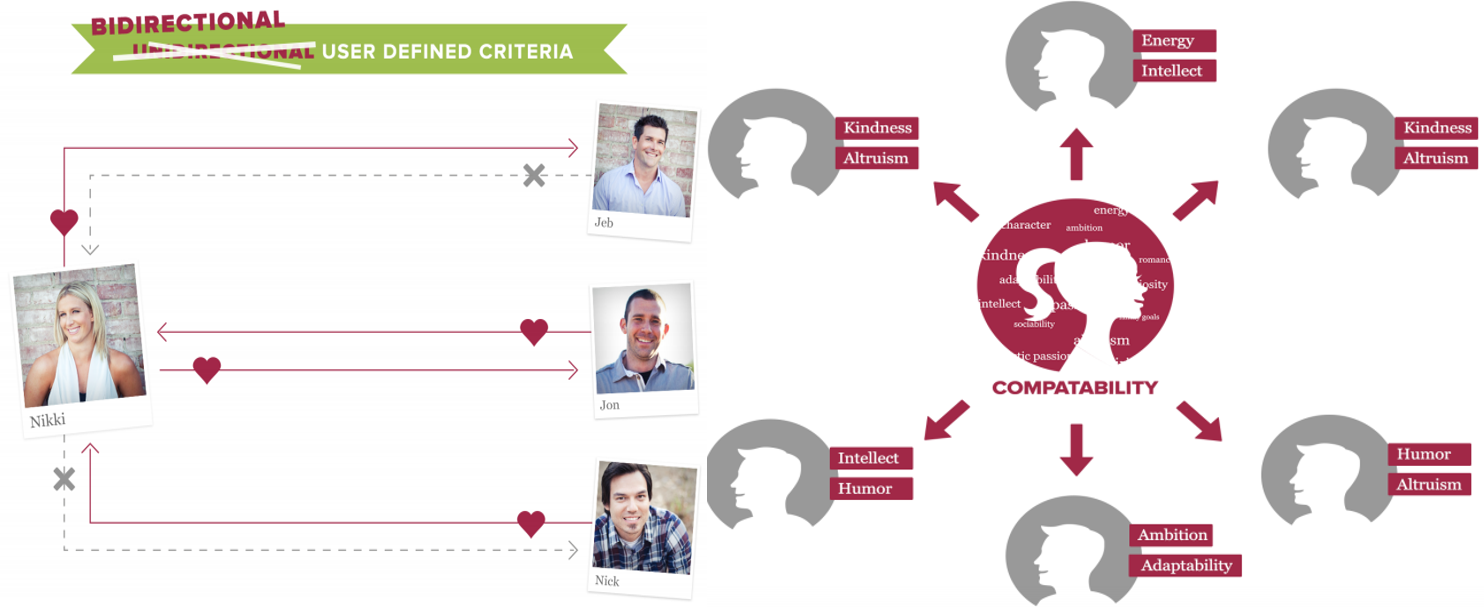Love, Sex and Predictive Analytics
Here, we are trying to understand the working mechanisms of dating sites, algorithms used and role of predictive analytics while matchmaking. We have also gleaned some interesting analytical insights from them.
By Ravi Kalakota, PhD (LiquidHub).
“Have we got a girl for you” – some very sophisticated predictive analytics are powering the online dating or hookup world. A lot of innovation is taking place around real-time, geo-location based matching services.
Take for Match.com which debuted its online dating first site in the U.S. in April 1995. Today, the Match.com brand hosts sites in 24 countries, in fifteen different languages spanning five continents. Match.com offers an interactive way for singles to meet other singles with whom they might otherwise never cross paths.
How to model and predict human attraction? Match.com is powered by Synapse algorithm. Synapse learns about its users in ways similar to sites like Amazon, Neflix, and Pandora to recommend new products, movies, or songs based on a user’s preferences.
Match.com uses Chemistry.com to do personalized surveys and get detailed preference data. But when it comes to matching people based on their potential love and mutual attraction, however, analytics get significantly more complex when you are attempting to predict mutual match… the person A is a potential match for person B…. but with high probability that person B is also interested in person A.
The challenge in predictive modeling in dating sites is in understanding what self-reported data is “real” in the prediction models. People have a tendency to lie (or exaggerate) about age, body type, height, education, interests etc. So excluding certain variables or taking a multi-dimensional scoring approach with different weights would be appropriate.
Love and hookup are exploding with numerous companies that are attempting better matchmaking than Match.com….
- OkCupid — This dating service provides a slew of questions to mathematically match you up with a compatible date. Its “broadcast” service, which sends out a note to those in your vicinity, is an especially useful way to spend a few spare moments.
- Blendr/Grindr – The gay men-finding app Grindr has gained an impressive following of 4 million users, and its co-ed partner, Blendr, is following suit. Both allow you search the social network of nearby singles looking to connect. Good for: Casual flings but leverages the mobile location data.
- Tinder — Using Facebook to determine mutual friends, interests and location, Tinder will match with compatible users. “Like” a profile and if they like you back, you two can see more information about each other, chat and make plans. Good for: The dater who values privacy.
- eHarmony – Same as Match.com but aimed at finding love. The selling angle is the ability to find a mate and higher odds of getting married.
- Badoo — Badoo, a London-based online service focusing on Spaniards, Italians and French by making it easier to find people nearby looking for romance. Badoo has signed up some 200 million people worldwide, 25 million of them active users.
Source: eharmony and MongoDB
Tinder – High-Speed Hookup and Matchmaking for Millennials
Login with Facebook and instantly begin flipping through profiles of nearby women (or men). Tinder uses location services to find other users in a certain area. The ease of use (swipe right (like) or swipe left (dislike)) and fast pace of Tinder are probably what make the app so addictive. According to The New York Times, Tinder has over 50 million active users. Just check out the user activity stats:
Tinder’s engagement is staggering. The company said that, on average, people log into the app 11 times a day. Women spend as much as 8.5 minutes swiping left and right during a single session; men spend 7.2 minutes. All of this can add up to 90 minutes each day.
Add that all up and you’ve got billions of swipes, which puts Tinder into the realm of serious personal Big Data.
According to a job posting for an analytics engineer, Tinder uses Java, Hadoop, Data Analysis, MapReduce, Algorithms, Clojure, Unix, Hive and using the AWS Cloud.
From a UX design, Tinder went Mobile First. This allowed it to create a better user experience unlike other online dating websites that did a lift-and-shift of their existing (desktop) user experiences to mobile.
How do these hookup sites work?
Consider Badoo. Badoo subscribers sign up by posting a photo and basic personal details. Location-based technology lets them check in via smartphone to find users and see how many feet away they are at that moment.
A feature called Encounters lets Badoo users flip through photos and mark them with green if they like what they see, orange if they’re not sure, and red if they’re not interested. When two people mark each other as green, Badoo contacts both and suggests they initiate a chat.
OkCupid, matches users with one another using match percentages, which quantifies how much users have in common, along with their popularity and in-box messages. According to Scientific American, “On any dating site a small subset of users will receive the majority of the messages. To even this out they look at the number of unread in-box messages and place users further down the match list if he/she has tons of them. The popularity metric (which isn’t displayed on people’s profiles) helps them match people with similar status on the site.”
Romance Graph for you? Companies like Hinge are building a romance graph of what structured data clues suggest two people will want to date. While Hinge’s app might not be as carefree as swiping through Tinder’s seemingly endless queue of mates, it delivers a daily set of tailored matches based on your profession, education history, and interests, as well who you’ve had the hots for in the past.
Active usage of “love” sites (social networks for meeting new people) is staggering. Tinder is doing 1+ billion swipes and 10+ million matches a day. Jiayuan, the biggest dating service in China, is estimated to have 19+ million active users as of September 2013 . Meetic had 16+ million users, Match.com 8+ million and OkCupid 2+ million (according to comScore).
Some interesting analytical insights from dating sites data:
- Women get 60% more attention if photo is taken indoors
- Men get 19% more attention if theirs is taken outside
- Full-body photos boost both sexes success by 203%
- Posing with animals or your best friends might seem cute but it actually reduces your popularity by 53 per cent (men) and 42% (women)
- Men get 8% fewer messages if they put up selfies.
- Mentions of words like divorce and separated gets men 52% more messages
- Women who are more forward, using phrases like dinner, drinks or lunch in the first message get 73% more replies, while men should play it cooler. Those who mention the same words in their opening message get 35% fewer replies.
Now I say Tinder, you say Match.com :-) May the best algorithm win.
References:
Tinder: Increase Hookups Using Metrics-Driven Product Design
Scientific American – Dating Services Tinker with the Algorithms of Love
MongoDB at eHarmony – Slideshare.net presentation – Big data at Scale
- 3B+ potential matches daily ~ 25+ TB of data
- 60M+ multi-attribute queries daily looking across 250+ attributes
- 212M+ photos ~ 15+ TB of data
- 4B+ relationship questionnaires ~ 25+ TB of data
Bio: Ravi Kalakota Ph.D is a Partner at LiquidHub in New York, a rapidly growing global professional services firm with around 1,200+ professionals. Ravi has authored 10 books and more than 25 journal articles. In his consulting work, Ravi has helped organizations revitalize their management and execution practices.
Related



